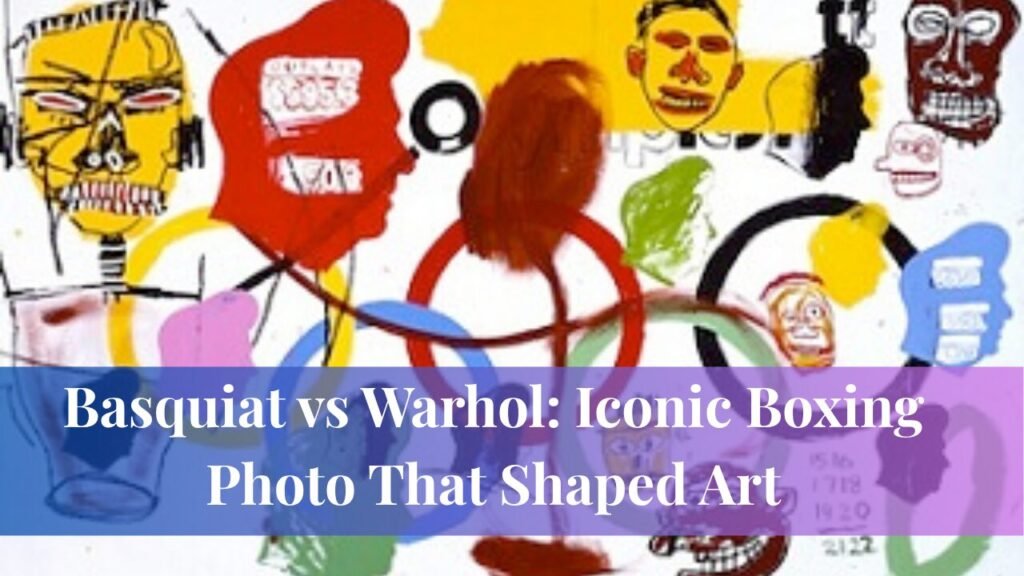In 1985, the art world witnessed an electrifying moment that perfectly encapsulated the dynamic relationship between two of the 20th century’s most iconic artists: Jean-Michel Basquiat and Andy Warhol. Captured in a now-legendary photo shoot by Michael Halsband, the image of “Basquiat and Warhol boxing” not only symbolized their creative rivalry but also immortalized their collaborative spirit. This visual moment became a powerful metaphor for artistic tension, friendship, and the merging of distinct creative legacies.
The idea for the boxing-themed shoot came from their gallerist, Bruno Bischofberger. Wanting a striking image to promote their upcoming joint exhibition, Bischofberger proposed that they pose as boxers. The concept represented the competitive yet collaborative energy between the two. The shoot took place just before their exhibition opened at Tony Shafrazi Gallery in New York, and it set the tone for how their partnership would be publicly perceived.
A Conceptual Collaboration
Warhol and Basquiat’s partnership in the mid-1980s brought together two very different worlds. Warhol, the seasoned pop art pioneer, had already achieved global fame. Basquiat, a rising star from the streets of New York, was redefining contemporary art with his raw, graffiti-inspired style. Their collaboration blurred the boundaries between art, fame, and commerce, and the boxing photo became a symbol of that intersection.
The shoot wasn’t just a promotional gimmick it was a statement. The two artists embraced the theatricality of the concept, playing into their perceived roles while also revealing a genuine connection beneath the surface. The imagery of them in the boxing ring came to represent both the creative friction and mutual respect that fueled their work together.
The Photographer Michael Halsband
Michael Halsband, known for his intimate and striking portraits, was chosen to capture this ambitious concept. He had previously photographed Mick Jagger and Keith Richards for the “Tattoo You” album, and he brought the same sharp energy to this shoot. His approach emphasized contrasts: Warhol’s pale, almost spectral presence against Basquiat’s lean, youthful vitality.
Halsband later recalled that Basquiat fully embraced the idea, approaching it with seriousness and enthusiasm. Warhol, in contrast, appeared more reserved, almost shy about the whole affair. This difference in demeanor only heightened the visual impact of the photographs, underlining their distinct personalities and artistic styles.
Symbolism and Interpretations
The boxing imagery quickly transcended its promotional purpose. It became a metaphor for opposing forces youth and age, street and gallery, rawness and polish, fame and authenticity. Basquiat’s intense focus in the photos contrasted sharply with Warhol’s more performative stance, creating a visual narrative that spoke volumes about their artistic dynamic.
Art critics have debated the deeper meaning of these images for decades. Some interpreted the photos as Basquiat symbolically “defeating” the old guard, ushering in a new era of art. Others saw it as a clever publicity stunt engineered by Warhol, whose understanding of media was unmatched. Halsband himself insisted that the shoot was less about rivalry and more about friendship, a genuine expression of mutual admiration.
The Exhibition and Its Aftermath
The joint exhibition featured more than 160 works they had created together. Typically, Warhol would lay down corporate logos and pop imagery, while Basquiat would layer on expressive brushwork, cryptic text, and bursts of chaotic energy. The result was a fusion of their distinct approaches a kind of visual conversation between two strong artistic voices.
The reception was mixed. Some critics dismissed the show as a cynical attempt by Warhol to stay relevant through Basquiat’s rising fame. Others praised it as a daring blend of different perspectives. Over time, the art world’s opinion evolved, and today these works are seen as innovative and ahead of their time, offering pointed commentary on race, celebrity, and commodification in art.
Critical Reappraisal
In retrospect, the collaboration anticipated many trends that dominate the art world today. The blending of branding and fine art, the embrace of celebrity culture, and the blurring of authorship in collaborative projects are now commonplace. Warhol and Basquiat’s works together are studied not only for their aesthetic qualities but also for their cultural foresight.
Initially misunderstood, their canvases are now considered highly valuable and historically significant. The boxing image, in particular, has endured as a visual shorthand for the productive tension that can arise when two creative forces meet.
Cultural Legacy of the Boxing Photos
Over the decades, the “Basquiat and Warhol boxing” image has become far more than a relic of 1980s art culture it’s an icon. It represents the creative tension that sparks innovation, the interplay of collaboration and competition, and the meeting of two vastly different artistic minds.
Modern culture continues to draw from its power. Fashion brands like Supreme, Uniqlo, and Off-White have incorporated the image into clothing lines. Major art institutions such as The Broad and MoMA have featured it in exhibitions and promotional materials. The photo has even been referenced in music, including hip-hop tracks by Jay-Z and Kanye West.
Michael Halsband’s Enduring Contribution
Halsband’s original print of the boxing image is part of the Andy Warhol Museum’s collection. It remains one of the most requested and licensed works from both artists’ legacies. Copies continue to sell at high prices, and the image regularly appears in exhibitions around the world.
This ongoing popularity speaks not only to the photograph’s visual impact but also to its layered meanings. The boxing stance, while staged, feels authentic because it reflects the truth of their relationship complex, charged, and deeply influential.
Warhol and Basquiat’s Friendship
Beneath the public spectacle, Warhol and Basquiat shared a real bond. They understood each other’s vulnerabilities and ambitions in ways that few others could. Warhol appreciated Basquiat’s raw creativity, while Basquiat respected Warhol’s mastery of self-promotion and his place in art history.
Their time together extended beyond the studio. They attended dinners, art openings, and traveled together, forging a personal connection that was sometimes overshadowed by public perception. While outsiders speculated about exploitation, those close to them often described their relationship as mutually beneficial and sincere.
The End of the Partnership
Like many creative partnerships, theirs eventually unraveled. By 1986, the sting of critical backlash had begun to strain their friendship. Basquiat, particularly sensitive to negative press, grew distant. Warhol’s sudden death in 1987 deeply affected him, and within a year Basquiat too was gone, a victim of his struggles with addiction at just 27 years old.
The boxing image took on new poignancy after their deaths. What had once been a playful and provocative promotional piece became a bittersweet reminder of two extraordinary talents whose time together and in the world was all too brief.
The Boxing Photo in Academic Discourse
In academic circles, the photo is frequently analyzed as a case study in postmodern collaboration, media manipulation, and the racial and generational dynamics of the elite art world. Scholars have noted that it subverts typical portrayals of the time, with the older white artist appearing vulnerable and the younger Black artist in a position of dominance.
This inversion challenges assumptions about hierarchy in the art world and continues to generate scholarly discussion. The image’s commercial life on posters, apparel, and other merchandise also fuels debate about the commodification of art and the blurred line between creative expression and branding.
Commercial Impact and Branding
The commercial reach of the boxing photo has been enormous. Licensing deals are lucrative, and exhibitions referencing the shoot draw substantial crowds. The image’s use on products from coffee mugs to high-end fashion pieces underscores how seamlessly it has moved between the worlds of high art and mass consumption.
Both Warhol and Basquiat were aware of, and even complicit in, the commercialization of their images during their lifetimes. In that sense, the boxing photo’s commercial success is an extension of their shared exploration of art as both cultural commentary and consumer product.
FAQs
What year was the boxing photo of Basquiat and Warhol taken?
The photo shoot took place in 1985, just before their joint exhibition at Tony Shafrazi Gallery in New York.
Who took the famous boxing photo of Basquiat and Warhol?
Michael Halsband, a renowned portrait photographer, captured the now-iconic images.
Was the boxing photo a real fight or staged?
The shoot was entirely staged. The concept was created for promotional purposes but quickly took on deeper symbolic meanings.
What was the public reaction to the photo?
Reactions were mixed at the time, but the photo has since become iconic, symbolizing artistic rivalry and collaboration.
Are there more photos from the session?
Yes, many more photos exist, including unpublished ones that show a more candid side of both artists.
Where can I see the original photo today?
The original print is part of the collection at The Andy Warhol Museum and is also featured in many global exhibitions.
Conclusion
The Basquiat and Warhol boxing photo shoot remains one of the most compelling visual metaphors in contemporary art history. What started as a promotional concept evolved into a timeless image of two creative forces each with distinct voices, styles, and philosophies coming together to challenge, support, and inspire one another. Their relationship, much like the photograph itself, defies simple categorization. It was complex, messy, loving, competitive, and above all authentically human.
As we revisit these images decades later, they remind us that great art often emerges from tension, collaboration, and the courage to step into the ring with someone different from yourself. Their story and the iconic photo continues to resonate as a masterclass in artistic duality. Visit boxing essential to explore more.




